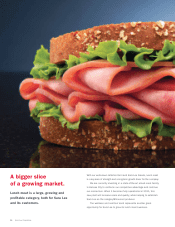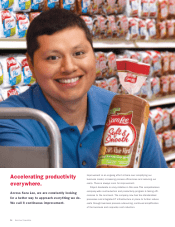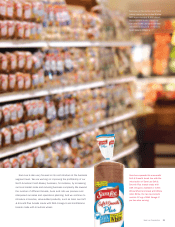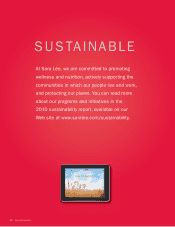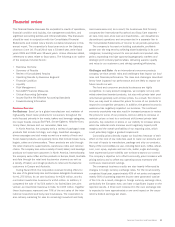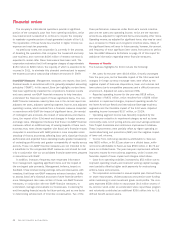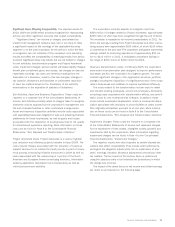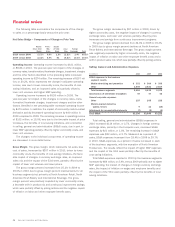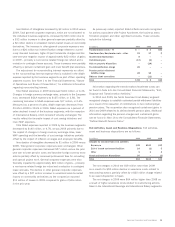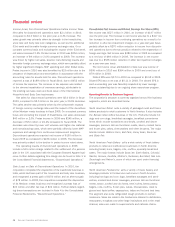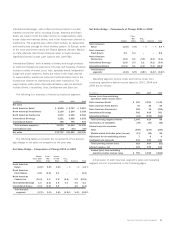Sara Lee 2010 Annual Report Download - page 21
Download and view the complete annual report
Please find page 21 of the 2010 Sara Lee annual report below. You can navigate through the pages in the report by either clicking on the pages listed below, or by using the keyword search tool below to find specific information within the annual report.Sara Lee Corporation and Subsidiaries 19
This Financial Review discusses the corporation’s results of operations,
financial condition and liquidity, risk management activities, and
significant accounting policies and critical estimates. This discussion
should be read in conjunction with the Consolidated Financial
Statements and related notes thereto contained elsewhere in this
annual report. The corporation’s fiscal year ends on the Saturday
closest to June 30. Fiscal 2010 was a 53-week year, while fiscal
years 2009 and 2008 were 52-week years. Unless otherwise stated,
references to years relate to fiscal years. The following is an outline
of the analysis included herein:
•Business Overview
•Summary of Results
•Review of Consolidated Results
•Operating Results by Business Segment
•Financial Condition
•Liquidity
•Risk Management
•Non-GAAP Financial Measures
•Critical Accounting Estimates
•Issued But Not Yet Effective Accounting Standards
•Forward-Looking Information
Business Overview
Our Business Sara Lee is a global manufacturer and marketer of
high-quality, brand name products for consumers throughout the
world focused primarily in the meats, bakery and beverage categories.
Our major brands include
Ball Park, Douwe Egberts, Hillshire Farm,
Jimmy Dean, Senseo
and our namesake,
Sara Lee
.
In North America, the company sells a variety of packaged meat
products that include hot dogs, corn dogs, breakfast sausages,
dinner sausages and deli meats as well as a variety of fresh and
frozen baked products and specialty items that include bread, buns,
bagels, cakes and cheesecakes. These products are sold through
the retail channel to supermarkets, warehouse clubs and national
chains. The company also sells a variety of meat, bakery and beverage
products to foodservice customers in North America. Internationally,
the company sells coffee and tea products in Europe, Brazil, Australia
and Asia through the retail and foodservice channels as well as
a variety of bakery and dough products to retail and foodservice
customers in Europe and Australia.
During fiscal 2010, the corporation received binding offers for
the sale of its global body care and European detergents businesses
for €1.275 billion, its air care business for €320 million, and its
non-Indian insecticides business for €154 million. In addition, it
completed the sale of its 51% stake in its Godrej Sara Lee joint
venture, an insecticide business in India, for €185 million. Together
these businesses represent over 70% of the net sales of the inter-
national household and body care businesses. The corporation is
also actively marketing for sale its remaining household and body
care businesses and, as a result, the businesses that formerly
comprised the International Household and Body Care segment –
air care, body care, shoe care and insecticides – are classified as
discontinued operations and are presented in a separate line in
the Consolidated Statements of Income for all periods presented.
The company is focused on building sustainable, profitable
growth over the long term by achieving share leadership in its core
categories; innovating around its core products and product cate-
gories; expanding into high opportunity geographic markets and
strategic joint ventures/partnerships; delivering superior quality
and value to our customers; and driving operating efficiencies.
Challenges and Risks As an international consumer products
company, we face certain risks and challenges that impact our busi-
ness and financial performance. The risks and challenges described
below have impacted our performance and are likely to impact our
future results as well.
The food and consumer products businesses are highly
competitive. In many product categories, we compete not only with
widely advertised branded products, but also with private label prod-
ucts that are generally sold at lower prices. As a result, from time to
time, we may need to reduce the prices for some of our products to
respond to competitive pressures. In addition, the general economic
weakness has negatively impacted our business. The continued
economic uncertainty may also result in increased pressure to reduce
the prices for some of our products, limit our ability to increase or
maintain prices or lead to a continued shift toward private label
products. Any reduction in prices or our inability to increase prices
when raw material costs increase could negatively impact profit
margins and the overall profitability of our reporting units, which
could potentially trigger a goodwill impairment.
Commodity prices directly impact our business because of their
effect on the cost of raw materials used to make our products and
the cost of inputs to manufacture, package and ship our products.
Many of the commodities we use, including beef, pork, coffee, wheat,
corn, corn syrup, soybean and corn oils, butter, sugar and energy,
have experienced price volatility due to factors beyond our control.
The company’s objective is to offset commodity price increases with
pricing actions and to offset any operating costs increases with
continuous improvement savings.
The company’s business results are also heavily influenced by
changes in foreign currency exchange rates. For the most recently
completed fiscal year, approximately 40% of net sales and approxi-
mately 50% of operating segment income were generated outside
of the U.S. As a result, changes in foreign currency exchange rates,
particularly the European euro, can have a significant impact on the
reported results. A three cent movement in the euro exchange rate
is expected to have approximately a one cent impact on the corpo-
ration’s diluted earnings per share.
Financial review



